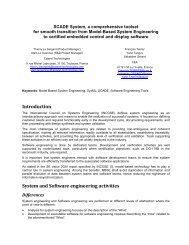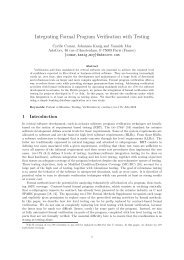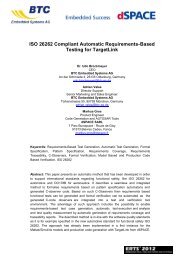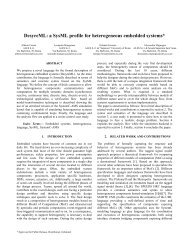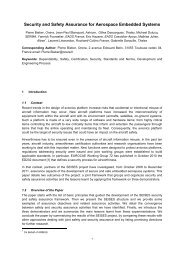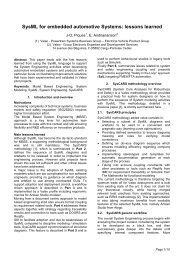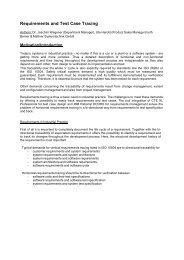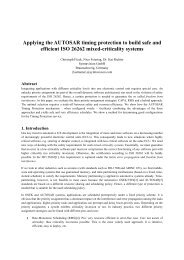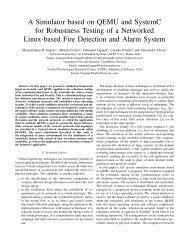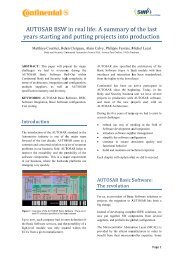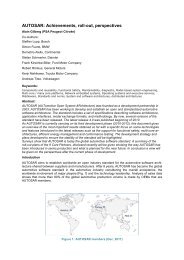Avionic-X: A demonstrator for the Next Generation Launcher Avionics
Avionic-X: A demonstrator for the Next Generation Launcher Avionics
Avionic-X: A demonstrator for the Next Generation Launcher Avionics
Create successful ePaper yourself
Turn your PDF publications into a flip-book with our unique Google optimized e-Paper software.
in a rack-based architecture (following <strong>the</strong> IMA trend) anduse of Time and Space Partitioning; second, a hotredundancy concept, and a communication based on a timetriggeredprotocol (see § III.C.1)).1) Toward a more integrated architecture (IMA)A “centralized” architecture is an architecture where <strong>the</strong>main tasks are executed on <strong>the</strong> same processing unit. In a“distributed” architecture, <strong>the</strong> tasks are distributed throughseveral equipments.The current Ariane 5 avionic architecture is mainlycentralized, as <strong>the</strong>re is an On-Board Computer (OBC)centralizing all <strong>the</strong> sensor data to compute <strong>the</strong> GNC and <strong>the</strong>sequential algorithms <strong>for</strong> commanding <strong>the</strong> launcher.However it is also partially distributed as o<strong>the</strong>r equipmentsalso have “intelligent” functions to per<strong>for</strong>m, be<strong>for</strong>e or after<strong>the</strong> OBC computations. The architecture is organized on a“master-slave” mode, meaning that <strong>the</strong> centralized OBCtakes all <strong>the</strong> decisions, based on <strong>the</strong> sensor inputs andmeasurements. This was a way to ensure <strong>the</strong> determinismrequired <strong>for</strong> a high level of reliability and availability.The choice of Ariane 5 was <strong>the</strong> result of a top-downallocation of <strong>the</strong> main avionics functions to differentequipments, with clear industrial perimeters andresponsibilities, accepting <strong>the</strong> fact that each industrial wouldprobably have to develop or to implement computing meansin an heterogeneous way and without any harmonization.In general this was not a problem as most of <strong>the</strong>equipments only needed very simple functions, easy toimplement within simple components such as DSP, ASIC orFPGA. But <strong>for</strong> complex equipments like <strong>the</strong> SRI (InertialMeasurement Unit), <strong>the</strong> computing unit could have beenharmonized or merged with <strong>the</strong> OBC itself.Today, <strong>the</strong> evolution of CPU capacity allows us toenvision a stronger centralization (or integration) of <strong>the</strong>architecture, <strong>for</strong> example by merging <strong>the</strong> SRI and OBCnumerical calculations on <strong>the</strong> same computing node, in orderto reduce <strong>the</strong> number of equipments and <strong>the</strong> associatedweight.We reach here <strong>the</strong> concept of Integrated Modular<strong>Avionic</strong>s, which comes from Aircraft development. Themain idea is to reduce <strong>the</strong> amount of embedded avionichardware by sharing <strong>the</strong> same hardware and softwareresources between various sub-systems. In this concept, astandardized CPU modules would allow to reuse <strong>the</strong> samemodule <strong>for</strong> all <strong>the</strong> launchers functions requiring computingcapabilities.This standard Processing Module would be physicallyregrouped with o<strong>the</strong>r standardized or specific modules inracks, as it has been done in <strong>the</strong> satellite industry (<strong>for</strong>example <strong>the</strong> Spacebus 4000 avionics concept described in[5]). Within <strong>Avionic</strong>-X we call this standard ProcessingModule “MDHB-X”, which stands <strong>for</strong> “Modular DataHandling Block” and is presented in § C.2).Modular Data Handling Block(MDHB-X)Power BoardEMPTYInertial BoardGNSS BoardFigure 4. Example of a rack-based architecture2) Redundancy conceptThe current Ariane 5 system is based on a duplexarchitecture composed of two onboard computers in hotredundancy. The nominal one is in charge of all operationson both avionics chains and <strong>the</strong> redundant one only spies asubset of <strong>the</strong> 1553 messages to maintain its own flightcontext. In case of auto-detected errors on <strong>the</strong> nominal OBC,an error signal is sent and a hand-over is done to <strong>the</strong>redundant OBC which takes <strong>the</strong> control of <strong>the</strong> 1553 busesand continues <strong>the</strong> mission. The redundant OBC becomes“<strong>the</strong> last survivor” and <strong>the</strong> nominal OBC cannot recover <strong>the</strong>flight control.The first redundancy concept which we aim at testing on<strong>Avionic</strong>-X is not dissimilar to Ariane 5’s one, but improves<strong>the</strong> transition phase and simplifies <strong>the</strong> design of <strong>the</strong> flightsoftware. As a matter of fact, in this concept both OBCsexecute <strong>the</strong> same software in parallel, and <strong>the</strong> selection of <strong>the</strong>command which shall be executed is per<strong>for</strong>med by <strong>the</strong>actuator. The failure of one OBC is <strong>the</strong>n almost transparent,hence a true “hot redundancy”. The reinsertion of <strong>the</strong> faultyOBC could also be envisioned, in case of a transient failurefollowed by a reset and successful auto-tests.This concept of “selection by <strong>the</strong> actuator” couldeventually be scalable to a triplex concept, <strong>for</strong> specificmissions where <strong>the</strong> exposition to natural radiativeenvironment could o<strong>the</strong>rwise lead to unacceptableunreliability figures.C. Technological enablersThe second activity branch of <strong>the</strong> project aims atidentifying innovative technological candidates (hardware,software, methods), per<strong>for</strong>ming trade-offs and feasibilitystudies w.r.t. a launcher system, and elaborating roadmaps tomature <strong>the</strong> relevant technological enablers up to TRL 6.The technologies we are looking at in <strong>the</strong> frame of <strong>the</strong><strong>Avionic</strong>-X shall cover <strong>the</strong> biggest part of a launcher avionics



